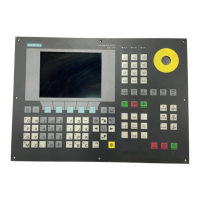Examples
4.2 Examples 3–6: SETTCOR function for tool environments
Tool Compensation (W1)
Function Manual, 08/2005 Edition, 6FC5397-0BP10-0BA0
4-11
If the sample program is continued after N110 with the following instructions:
N120 _CORVAL[0] = 0.0
N130 r1 = settcor(_CORVAL, "GW", 0, 3, 0)
N140 t1 d1 x0 y0 z0 ; ==> MCS position X24.330 Y0.000
Z17.500
the remaining wear is included completely in the geometry because the compensation is now
effective in the Z' axis (parameter _GEOAX is 0). Since the new compensation value is 0, the
total tool length and thus the position approached in N140 may not change. If _CORVAL
were not equal to 0 in N120, a new total tool length and thus a new position in N140 would
result, however, the wear component of the tool length would always be zero, i.e., the total
tool length is subsequently always contained in the geometry component of the tool.
The same result as that achieved by calling the SETTCOR function with the _CORCOMP = 0
parameter twice can also be reached by calling _CORRCOMP = 1 (vectorial compensation)
just once:
N10 def real _CORVAL[3]
N20 $TC_DP1[1,1] = 500 ; Turning tool
N30 $TC_DP3[1,1] = 10.0 ; Geometry L1
N40 $TC_DP4[1,1] = 15.0 ; Geometry L2
N50 $TC_DP12[1,1]= 10.0 ; Wear L1
N60 $TC_DP13[1,1]= 0.0 ; Wear L2
N70 _CORVAL[0] = 0.0
N71 _CORVAL[1] = 5.0
N72 _CORVAL[2] = 0.0
N80 rot y 30
N90 t1 d1 g18 g0
N100 r1 = settcor(_CORVAL, "GW", 1, 3, 1)
N110 t1 d1 x0 y0 z0 ; ==> MCS position X24.330 Y0.000
Z17.500
N120 M30
In this case, all wear components of the tool are set to zero immediately after the first call of
SETTCOR in N100.

